The Empty Corner of northeastern Wisconsin boasts a suite of brawling freestone rivers with which I have a longstanding love-hate relationship. I love them for their prideful beauty and for their occasional benevolences; I hate them for the way they draw me in, raise my hopes, and, as often as not, dash them.
But then, I suppose that’s only to be expected when you ignore the lessons of history.
Still, if forced to pick a favorite from this bevy of cruel mistresses, it would have to be the Peshtigo—in particular, the stunningly attractive five-mile stretch that, in a then-novel and extraordinarily far-sighted move, was designated fly-fishing-only in the early 1950s.
I’ve landed some dandy browns there over the years but the fish I remember best, not surprisingly, was The One That Got Away. The stage for this tragedy was a pool of deep, heavy water where a lakelike shallows necked down. A wall of huge submerged boulders—they looked like the ruins of a medieval battlement—reposed along the pool’s near side. It was the kind of place you couldn’t imagine anything but a big fish living in.
Reasoning that a big fish would be tempted only by a big meal, and having observed numerous crayfish scuttling around, I tied on a rust-and-gold Clouser—a plausible imitation of a crayfish that would sink in a hurry. Starting at the top of the pool, I tossed the Clouser across and a little upstream, threw in an upstream mend, let it drift on a slack line and then, when it came tight, twitched it back along the sunken wall. Wanting to be sure I had enough gun, I’d broken out the 7-weight with this specific scenario in mind.
More Like This
I covered the water as thoroughly and methodically as I could, and for once it paid off. About two-thirds of the way through the pool, just as I began my retrieve, I got a bone-jarring strike. In less time than it takes to type this, the fish was 30 yards downstream and I was having the unfamiliar experience of watching backing hiss through the guides.
The fish’s momentum finally stalled, and with the rod bent to the corks I was able to winch him halfway back. At that point, aided by the stiff current, he dug in and refused to budge. It was a salmon-like tactic, and when I got a brief, shadowy glimpse of his tail it looked salmon-sized. I went a little cotton-mouthed then, knowing that this was certainly the biggest stream trout I’d ever been attached to.
The stalemate continued, me pulling as hard as I dared, the fish stubbornly holding its ground. Then I felt a short, violent tug, then another, and while I was pondering what this might signify, and how best to respond, the hook pulled out.
If you go to that pool and listen hard, you can still hear the echo of my anguished howl.
For obscure reasons, I hadn’t been to the Peshtigo for a number of years. So when I found myself needing a night off from the domestic grind, the vision of that braided, boulder-studded jewel, set so deeply within the vee of its wooded banks that it feels like a hidden Shangri-La, became the bright light on a clouded horizon.
My wife, who’d been in a funk about, well, everything, accused me of not wanting to be around her.
“It’s a matter of dosage,” I explained.
The approach to the fly-fishing water is a winding two-track that begins on the high ground of a droughty pine-oak barrens. It then descends through zones of increasing verdure until, at the river, it traces through an almost tropically lush mantle of green.
I scraped through the trail leading upstream, scrambled down the bank, and flushed a brood of mergansers from the rocky shallows. Something I’d forgotten was how treacherous this stretch is to wade, its litter of large, eccentrically tilted slabs resembling a flooded demolition site.
What I hadn’t forgotten was the way a bald eagle always appeared shortly after my arrival, followed invariably by an osprey. And now, on cue, here they came: first the eagle, rowing heavily downstream as it mirrored the river’s course, then the more elegant and buoyant osprey. A kingfisher, its staccato chatter like an air wrench loosening a rusty lug nut, flashed through a fretwork of light and shadow; sharp-eyed cedar waxwings darted from the streamside alders to pluck insects from midair.
A variety of bugs were coming off: creamy light cahills, a few larger mayflies that I tentatively ID’d as gray drakes, a sprinkling of yellow sally stones. Caddisflies—tan sedges, I guessed—fluttered from the riffles in steady procession. The waxwings were clearly keying on them, but the trout hadn’t turned on yet. I stood where I could scan a long tongue of deeper, faster water that funneled between a midriver gravel bar and a steep bank. Overhanging branches offered protection (but not so much that I couldn’t sidearm a fly beneath them), a few scattered boulders broke the flow, there was a well-defined foam line—you couldn’t have drawn it up any better.
About eight o’clock the caddis hatch ramped up considerably; still, nothing rose. Finally, about 30 yards downstream, I saw a heavy double-ended splash—the kind of emphatic disturbance a big trout makes when chasing a skittering caddisfly.
I eased into position a few feet upstream and fed the size 14 Elk-Hair into the sweet spot. I ran it through there several times, and while the drifts looked good (the current was running right-to-left) the trout was unimpressed. I couldn’t imagine I’d put him down, and I was confident about the pattern, so I hooked the fly in the keeper ring and waited. And waited. Somewhere in the hemlock forest above me, a deer wheezily snorted its impatience.
I was beginning to lose faith when the trout slurped a natural with a classic head-and-tail rise that remains gorgeously etched in my memory. He was a bit upstream and inshore from where I’d originally pegged him, and even in that grainy light I could see he wasn’t the brown I expected but a rainbow—rare in these parts. I could also see that he had shoulders.
He took on the second cast, another classic porpoising rise, and when I tightened on him he bolted downstream as if he’d been tickled with an electric prod. He was on the reel in a heartbeat—which isn’t to say I had control of the situation. I managed to keep him out of the rocks at the end of the run, but that was the extent of my influence. He shook his head, the rod bucked, and the hook pulled out.
I was the happiest disappointed person you’ve ever seen. Instead of howling my despair, I laughed out loud. The kingfisher was still chattering, and I left the river to him.





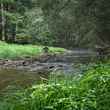







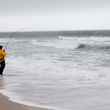




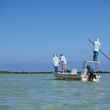



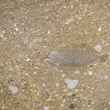

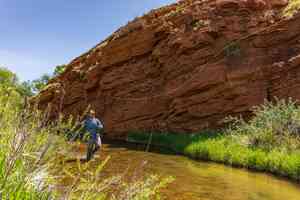




Comments